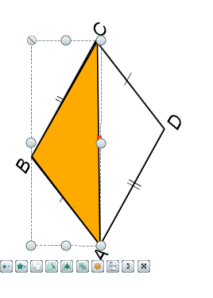CCSS-M. G-CO.B.8. Explain how the criteria for triangle congruence (ASA, SAS, and SSS) follow from the definition of congruence in terms of rigid motions.
This standard made me realize that the textbooks I had used for a long time allowed the ASA, SAS, and SSS Triangle Congruence Theorems into our deductive system as postulates. We’ve always proved SAA and HL, but for some reason I thought the others were in the back of the book in a section of more challenging proofs of theorems. (I at least knew that the proofs weren’t left as an “exercise” for students at the end of the section on congruent triangles.)
How can we use rigid motions to show that SAS always works?
Here is one student’s suggestion.
We’ve mapped ∆ABC to ∆DEF with C to F using vector CF, and rotating ∆A’B’C’ about F using angle C’A’D will map one triangle on top of the other. But have we used the given SAS? We know that ∠B≅∠E, not that ∠C≅∠F.
Here is another student’s suggestion.

Once you’ve mapped C to F using vector CF, the student suggests rotating the new triangle 180˚ about C.
We know that using dynamic geometry software doesn’t prove our results for us.
But using dynamic geometry software does help convince us that we are proving the right thing. I cannot remember where I recently read (a Tweet? a blog post?) that students need to be convinced a statement is true before they will expend effort proving it. It takes a lot of Math Practice 3 for us to make it through explanations for why SSS, SAS, and ASA provide sufficient information for proving triangles congruent.
We can use a translation and a rotation, but we need to map ∆ABC to ∆DEF with B to E using vector BE. We know that ∆A’B’C’ is congruent to ∆ABC because a translation preserves congruence.

Then what rotation will ensure that ∠B’ maps onto ∠E?
Rotating ∆A’B’C’ about E using angle C’EF will leave E=B’=B’’. B’’C’’=EF because a rotation preserves congruence. A”B”=DE because a rotation preserves congruence, and ∠B≅∠E because a rotation preserves congruence.
If the given triangles do not have the same orientation, a reflection will be necessary, which could then be followed by a translation and/or a rotation as needed. Note: I’ve recently seen different interpretations of “orientation”. We say two figures have the same orientation if the clockwise order of the vertices is the same.
Even if the triangles do have the same orientation, a reflection or sequence of reflections can be used.
Since EF=EC’, E is on the perpendicular bisector of C’F. Reflecting ∆A’B’C’ about the perpendicular bisector of segment C’F will leave E=B’=B’’ since a point on the line of reflection will be its own image.
Since ∠DEF≅∠C’EA’ and EA’=ED, A’ and D will also have to coincide after the reflection about the perpendicular bisector of C’F.
Thus, ∆ABC≅∆A’B’C’≅∆DEF.
Thinking through the proofs of SSS and SAS make our traditional congruent triangle problems look like a waste of time.
Can we show that the two triangles are congruent?
Students look at this and immediately see that one triangle is a rotation of the other 180˚ about the midpoint of segment AC.
Students look at this problem and see the same rigid motion to prove congruence.
And another, except that this time, someone initially suggested a reflection about segment AC.
Can we recover showing congruence from the initial reflection?
Of course … another reflection about the perpendicular bisector of segment AC shows the given triangles congruent.
And then we think about why that works.
As the journey continues, I am grateful for standards that push my students and me to think outside our comfort zone, giving all of us the opportunity to make sense of problems and persevere in solving them.
—
Resources:
From Illustrative Mathematics, Why does SAS work?














